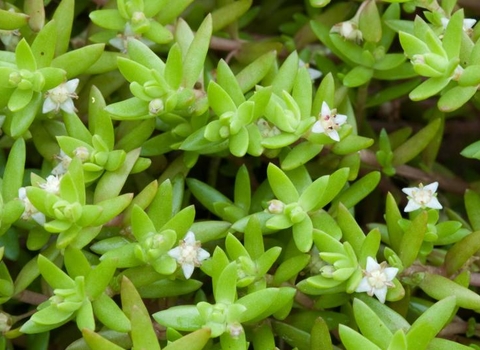New Zealand Pygmyweed or Australian Stonecrop (Crassula helmsii) is a perennial with yellowish-green, succulent leaves and solitary white or pale pink flowers. It grows in ponds, lakes, reservoirs, canals, and ditches, as well as on damp mud at the margins of waterbodies. It tolerates a range of pH conditions, from acidic to alkaline and even slightly salty areas.
Native to coastal regions of southern Australia, Tasmania and New Zealand, C. helmsii was brought to Great Britain in 1911 for sale as an oxygenating plant for ponds. It was first recorded growing in the wild in Essex that same year. Its continued spread is almost certainly by vegetative fragments on boats, machinery used to manage waterbodies, clothing and possibly wildfowl. It can root from a mere 10mm of stem. In addition, turions, short shoots, which break off easily, are produced in autumn; and as these float, they are an effective means of colonisation within wetland systems. It is possible that new introductions continue as a result of people discarding pond plants.
New Zealand pygmyweed forms dense mats from 0.5m above to 3m below water level, over many square metres. This shades out other plant species and causes oxygen depletion over the underlying water column. Eventually this leads to a decline in invertebrates such as dragonflies, frogs, newts and fishes - no species are known to preferentially graze C. helmsii. It may cause extensive declines in native plants and prevent recreational and commercial activities.
Crassula Action Plan
We undertook an evaluation of the status of Mannez pond, within the Longis Reserve, in 2012. New Zealand Pygmyweed was found to cover 100% of the surface area in some sections of the pond. Native water milfoils were also present, but in lower numbers; and Amphibious Bistort (Persicaria amphibia) appeared to be declining. Invertebrate fauna was dominated by Water Hoglice (Asellus aquaticus), which indicates low dissolved oxygen levels. This could be symptomatic of the high C. helmsii coverage.

